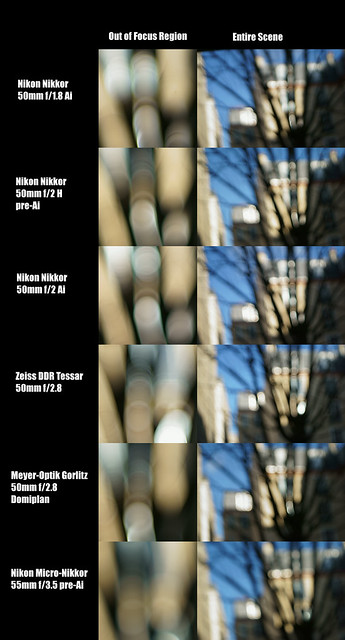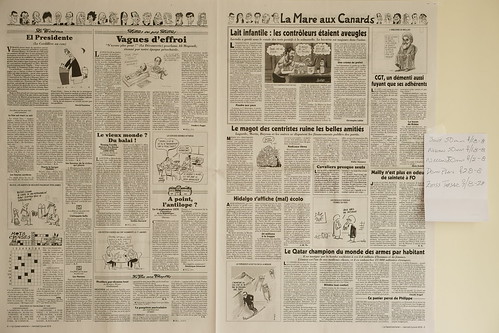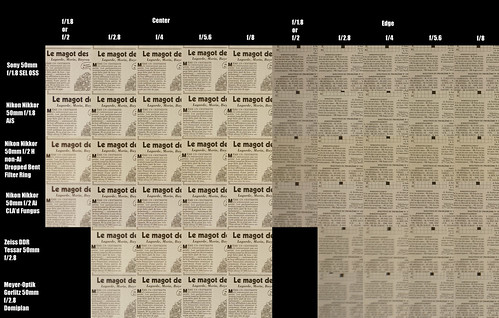... once more into the abyss, shall we?
Today I would like to take a look at several 135mm lenses that I happen to have on hand just now. Two lenses are new to the Toy Box. One arrived as part of a stack of things I purchased. I'd inspected it in the field but failed to notice "cleaning marks" (scratches) on the front element. The second lens arrived as part of the Super Deal that I scored off eBay point fr and it set me back all of 7 Euro.
Setup
Here is the overall scene.
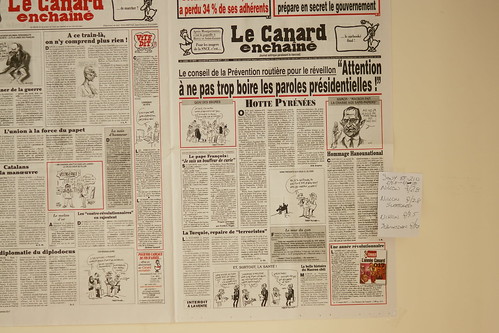
Here are the results.
[If you click on the image it'll take you to the Flickr hosting site. Once there, look at the file at full resolution. In many cases the differences between lenses is small and likely can't be seen until you take a squint at the comparison at 100 percent.]
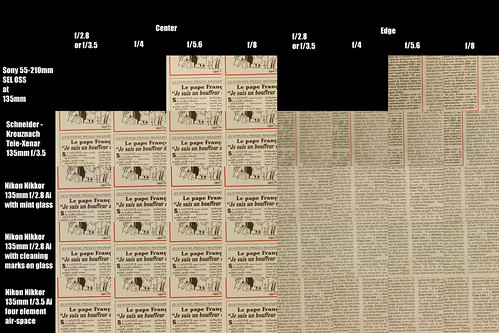
Comments
Starting with the Sony 55-210mm f/4.5-6.3 SEL OSS, what I see is that it's sharp in the center at 135mm from wide open (which in this case is only f/5.6). The edges of the scene are a little soft and distorted. This may be due to field curvature, or it might be due to the inexpensive zoom design. Photographing 2D subjects is always trying for non-flat field lenses (most optics are non-flat field). For the price ($100 used) this is a usable lens.
Next up is the Schneider-Kreuznach Tele-Xenar 135mm f/3.5. This is a lens I picked up for 7 Euros. I needed to clean the front two lens groups. One was fogged and the other looked like fungus was starting to grow around the edges. Once cleaned up and after the Exakta adapter arrived I wanted to see how it behaved (hence this post).
In the center the Schneider is very sharp. At the edges, it takes time for things to clean up (f/8). Thinking back to the Sony comments, I wonder if field curvature might be coming into play. What's surprising is how sharp it is in the center given the age of the optic (manufactured in the mid-1960's in this case). I've always prefered Schneider to Zeiss lenses and this only confirms my already strong bias.
Another thing that I like about the Schneider 135mm is its size and weight. This is what I like about the Nikon Nikkor 135mm f/3.5 Ai, too. When compared side by side the f/2.8 Nikkors feel large, bloated, and heavy. The difference is remarkable. The depth of field effect moving from the f/3.5 to the f/2.8 optics (it's only half a stop, mind you) is indistinguishable.
The Nikon Nikkor 135mm f/2.8 Ai was given to me by a good friend. The glass is in mint condition. I thought it interesting to see how the scratched pre-Ai version I recently picked up performed by comparison. Minimally, if scratches impact performance I would expect to see a drop in contrast and perhaps a drop in resolution as well. Yet, what I see here is that both lenses are equally sharp and behave exactly the same way at all apertures. Looking at the results I can not honestly tell which lens is scratched and which isn't. Certainly the "cleaning marks" are light (they're not deep gouges), but to see absolutely no difference in performance? This is a very interesting "learning" for me.
Lastly, I think the Nikon Nikkor 135mm f/3.5 Ai should become my 135mm "control" lens. It is the standard by which I could measure all other 135mm lenses. It is brilliant from wide open straight across the field and at all apertures. All this "goodness" in a 45 Euro optic is impressive. There is nothing finer.
Today I would like to take a look at several 135mm lenses that I happen to have on hand just now. Two lenses are new to the Toy Box. One arrived as part of a stack of things I purchased. I'd inspected it in the field but failed to notice "cleaning marks" (scratches) on the front element. The second lens arrived as part of the Super Deal that I scored off eBay point fr and it set me back all of 7 Euro.
Setup
- Sony A6000, 100ISO, AWR converted in Sony's software
- Big Beefy Manfrotto tripod
- Lenses -
- Sony 55-210mm f/4.5-6.3 SEL OSS
- Nikon Nikkor 135mm f/2.8 Ai with mint condition glass
- Nikon Nikkor 135mm f/2.8 non-Ai with scratched front element ("cleaning marks")
- Nikon Nikkor 135mm f/3.5 Ai 4 element airspaced
- Schneider-Kreuznach Tele-Xenar 135mm f/3.5 Exakta mount
Comparison

Here are the results.
[If you click on the image it'll take you to the Flickr hosting site. Once there, look at the file at full resolution. In many cases the differences between lenses is small and likely can't be seen until you take a squint at the comparison at 100 percent.]

Comments
Starting with the Sony 55-210mm f/4.5-6.3 SEL OSS, what I see is that it's sharp in the center at 135mm from wide open (which in this case is only f/5.6). The edges of the scene are a little soft and distorted. This may be due to field curvature, or it might be due to the inexpensive zoom design. Photographing 2D subjects is always trying for non-flat field lenses (most optics are non-flat field). For the price ($100 used) this is a usable lens.
Next up is the Schneider-Kreuznach Tele-Xenar 135mm f/3.5. This is a lens I picked up for 7 Euros. I needed to clean the front two lens groups. One was fogged and the other looked like fungus was starting to grow around the edges. Once cleaned up and after the Exakta adapter arrived I wanted to see how it behaved (hence this post).
In the center the Schneider is very sharp. At the edges, it takes time for things to clean up (f/8). Thinking back to the Sony comments, I wonder if field curvature might be coming into play. What's surprising is how sharp it is in the center given the age of the optic (manufactured in the mid-1960's in this case). I've always prefered Schneider to Zeiss lenses and this only confirms my already strong bias.
Another thing that I like about the Schneider 135mm is its size and weight. This is what I like about the Nikon Nikkor 135mm f/3.5 Ai, too. When compared side by side the f/2.8 Nikkors feel large, bloated, and heavy. The difference is remarkable. The depth of field effect moving from the f/3.5 to the f/2.8 optics (it's only half a stop, mind you) is indistinguishable.
The Nikon Nikkor 135mm f/2.8 Ai was given to me by a good friend. The glass is in mint condition. I thought it interesting to see how the scratched pre-Ai version I recently picked up performed by comparison. Minimally, if scratches impact performance I would expect to see a drop in contrast and perhaps a drop in resolution as well. Yet, what I see here is that both lenses are equally sharp and behave exactly the same way at all apertures. Looking at the results I can not honestly tell which lens is scratched and which isn't. Certainly the "cleaning marks" are light (they're not deep gouges), but to see absolutely no difference in performance? This is a very interesting "learning" for me.
Lastly, I think the Nikon Nikkor 135mm f/3.5 Ai should become my 135mm "control" lens. It is the standard by which I could measure all other 135mm lenses. It is brilliant from wide open straight across the field and at all apertures. All this "goodness" in a 45 Euro optic is impressive. There is nothing finer.
